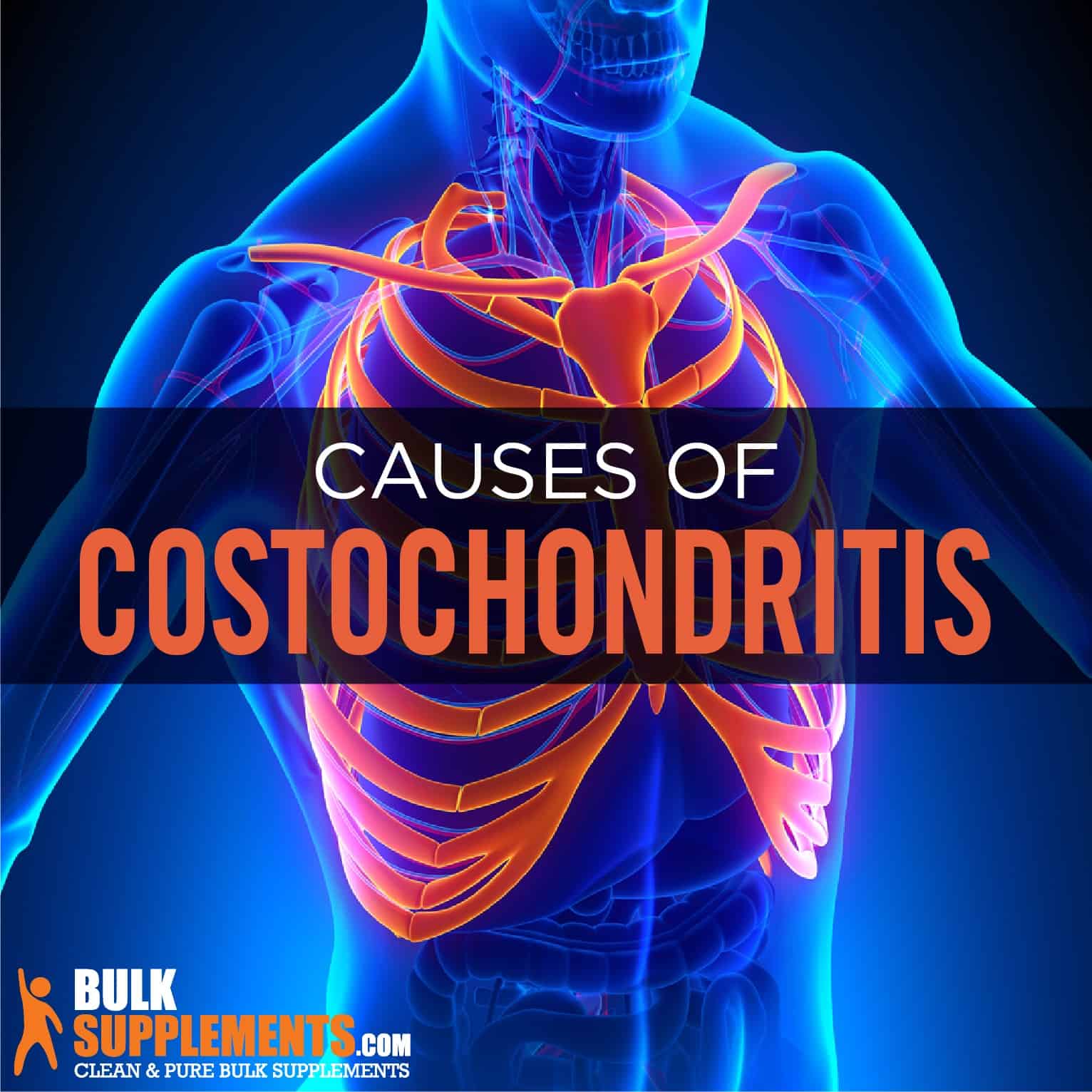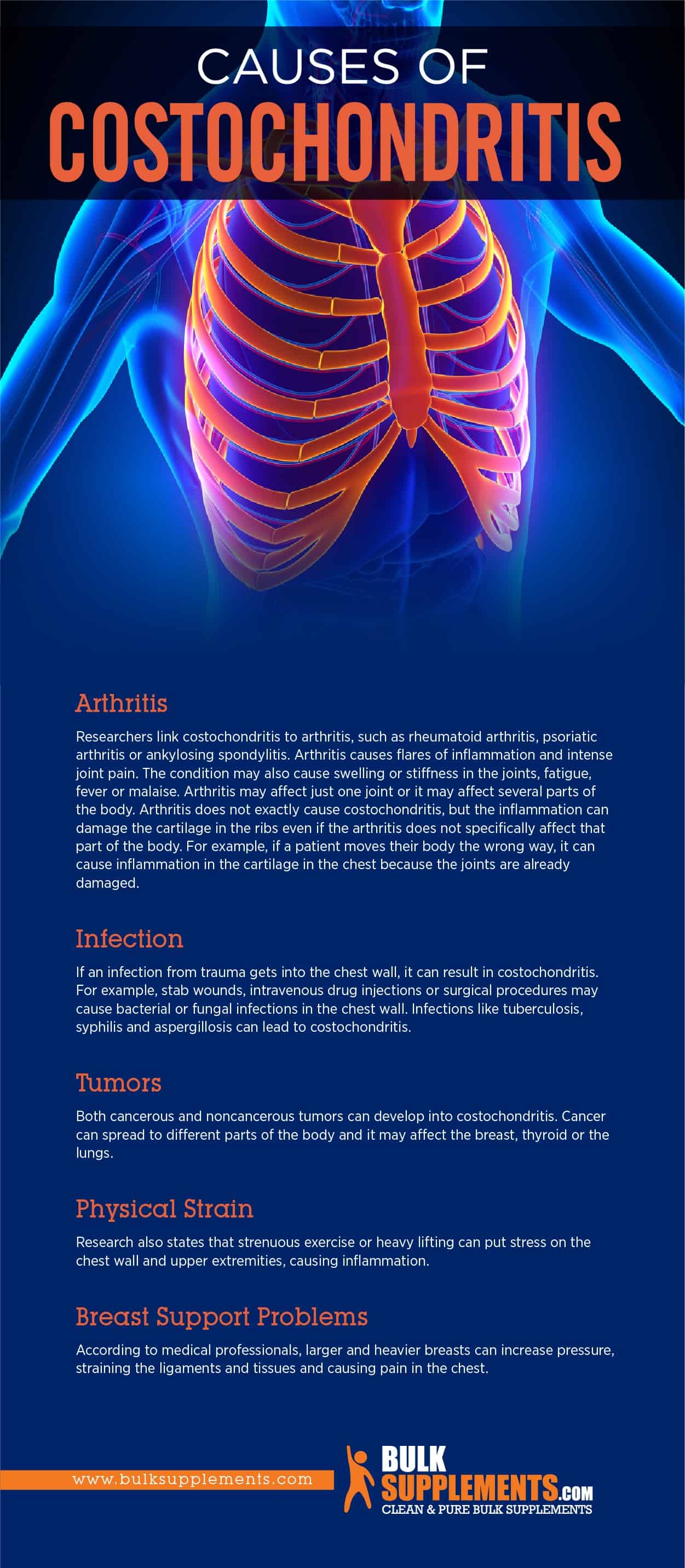Costochondritis: Causes, Symptoms & Treatment
by James Denlinger Digital Marketing Strategist
What is Costochondritis?
Cartilage is protective tissue in the body and in the chest, it joins the ribs to the breastbone. Costochondritis is a condition that causes inflammation in the costochondral junctions of the ribs. It may also affect the chondrosternal joints of the anterior chest wall. This condition is common and usually temporary, but it can be very alarming and the pain can be extreme, similar to a heart attack.
Doctors refer to costochondritis as costosternal chondrodynia or costosternal syndrome. Usually, the condition resolves itself after a few weeks or a few months. It is important to note that doctors do not know what causes costochondritis, but they have identified some risk factors and associated conditions. It usually affects patients older than 40 and it is a common condition. In fact, doctors note that between 13 and 36 percent of patients who visit the emergency room for chest pain are suffering from this condition.
Symptoms of Costochondritis
The most noticeable symptom is stabbing, burning or aching pain in the chest. It is caused by inflammation in the cartilage that connects the ribs to the breastbone. Usually the condition affects the left side of the body, specifically the second to fifth ribs.
Tietze Syndrome
Tietze syndrome is a similar form of costochondritis and many people often confuse the two disorders. However, in addition to pain, tietze syndrome causes swelling as well. And while costochondritis affects people over 40, tietze syndrome usually affects teenagers and young adults. It causes inflammation in at least one cartilage, usually the second or third rib. Medical professionals do not know exactly how common this particular condition is, but it is very rare.
Causes of Costochondritis
Arthritis
Researchers link costochondritis to arthritis, such as rheumatoid arthritis, psoriatic arthritis or ankylosing spondylitis. Arthritis causes flares of inflammation and intense joint pain. The condition may also cause swelling or stiffness in the joints, fatigue, fever or malaise. Arthritis may affect just one joint or it may affect several parts of the body. Arthritis does not exactly cause costochondritis, but the inflammation can damage the cartilage in the ribs even if the arthritis does not specifically affect that part of the body. For example, if a patient moves their body the wrong way, it can cause inflammation in the cartilage in the chest because the joints are already damaged.
Infection
If an infection from trauma gets into the chest wall, it can result in costochondritis. For example, stab wounds, intravenous drug injections or surgical procedures may cause bacterial or fungal infections in the chest wall. Infections like tuberculosis, syphilis and aspergillosis can lead to costochondritis.
Tumors
Both cancerous and noncancerous tumors can develop into costochondritis. Cancer can spread to different parts of the body and it may affect the breast, thyroid or the lungs.
Physical Strain
Research also states that strenuous exercise or heavy lifting can put stress on the chest wall and upper extremities, causing inflammation.
Breast Support Problems
According to medical professionals, larger and heavier breasts can increase pressure, straining the ligaments and tissues and causing pain in the chest.

Treatment for Costochondritis
Although it is painful, costochondritis is generally a harmless condition. Usually the pain goes away on its own after a few weeks or a few months. Typically patients take analgesics—drugs to relieve pain—like acetaminophen or nonsteroidal anti-inflammatory drugs (NSAIDs). Patients can also apply heat to the chest to ease the discomfort. It is also important to avoid physical activities that may cause pain. Patients may also undergo physical therapy, but normally treatment just aims to address pain directly.
Supplements for Costochondritis
Supplements may be able to help patients manage pain and inflammation from costochondritis. However, there is no supplement that will completely cure or prevent the condition. Always consult a doctor before starting a supplement regimen to confirm safety.
Ginger
Ginger is anti-inflammatory, as well as a pain reliever and it is a very popular dietary ingredient. But it is also a common dietary supplement for health. Ginger is an antioxidant, contains anti-inflammatory contents and is embedded with therapeutic compounds such as shogaol, zingerone, paradol and gingerol. It may help reduce inflammation in conditions like irritable bowel disease, arthritis, diabetes, fibromyalgia and costochondritis. The supplement may be able to help patients control inflammation that a hyperactive immune response can cause and eliminate toxins in the body. The recommended dosage for ginger root extract powder is 1,000 mg (about ½ tsp) once a day with water to avoid heartburn. Consult a doctor for approval before taking this supplement.
Chamomile
For thousands of years patients have used chamomile to improve overall health. There are numerous health benefits of chamomile, including pain relief, calming anxiety and managing depression. It may also act as an effective remedy for ulcers, insomnia, acne, wounds, inflammation, arthritis and gastrointestinal conditions like constipation or acid reflux. As a dietary supplement, the recommended dosage for chamomile extract powder is 800 mg (about ⅓ tsp) once or twice a day. Take it with water as needed. Make sure to confirm the dosage with a doctor.
Curcumin
Curcumin is a component of turmeric, a type of ginger and a popular cooking spice. It is what gives turmeric its yellow color and people also use it as a yellow food coloring, but its main health benefit is reducing inflammation. Inflammation is a necessary immune response for repairing damage in the body, but when it occurs uncontrollably it can cause health issues, such as costochondritis. Inflammation also plays a role in Alzheimer’s disease, heart disease and cancer. Curcumin increases antioxidants in the body to eliminate oxidative damage and neutralize free radicals. As a dietary supplement, take 1,000 mg (about ½ tsp) of curcumin 95% natural turmeric extract powder per day, unless a doctor recommends a different dosage.
Ginseng
Ginseng root is an age-old natural remedy that supports overall health. It was discovered more than 5,000 years ago in China. Initially, it functioned as food but over time, people discovered its medicinal qualities. Research claims that it may improve sexual health, potentially reduce the risk of cancer, improve cognitive function, help with weight loss and reduce inflammation. Ginseng is a powerful antioxidant that can minimize inflammation before it can cause serious damage. The recommended dosage for ginseng root extract powder is 1,000 to 2,000 (about ½ to 1 tsp) up to twice a day. Make sure to consult a doctor before using this supplement.
Fennel
The wild fennel plant possibly originates in southern Europe, but now it is sold all over the world for its medicinal qualities. It roots, leafed tops and bulbs are edible. This plant is high in manganese, potassium, magnesium, vitamin C and calcium. It may be an effective antioxidant, potentially reducing the risk of cancer. Research states that fennel may also treat inflammation and other chronic conditions, like atherosclerosis that affects the heart. It can help stimulate the immune system to better fight off disease. The recommended dosage for fennel extract powder is 1,000 mg (½ tsp) once or twice a day, with a doctor’s approval.
Glucosamine
Glucosamine is an amino sugar that the body makes naturally. It forms in the fluid around the joints and cartilage. Research states that it can help relieve pain and discomfort in the joints, healing cartilage and reducing damage. It may help control conditions like arthritis and costochondritis to relieve pain and slow down progression. As a dietary supplement, the recommended dosage for D-glucosamine HCL powder is 1,000 mg (about ¼ tsp) up to three times a day, after consulting a doctor.
The Bottom Line
In conclusion, costochondritis is a condition that causes pain in the chest from inflammation in the cartilage around the costochondral junctions in the ribs and the chondrosternal joints in the anterior chest wall. It can cause severe pain, similar to a heart attack. However, costochondritis is common, generally harmless and the symptoms usually disappear on their own. Doctors have not identified a specific cause for the condition but several factors may play a role, such as rheumatoid arthritis, tumors or infections.
Treatment usually aims to control immediate pain with medication, although some patients may need physical therapy as well. There are also natural remedies like applying heat. Patients can also try natural herbal treatments, such as supplements. Natural supplements can help reduce inflammation and control pain, including chamomile, ginger, ginseng, glucosamine, curcumin and fennel. However, it’s important to consult a doctor because supplements do not cure any medical condition. Instead, they aim to improve overall health.
Sponsor Ads
Created on Mar 3rd 2020 22:41. Viewed 722 times.



